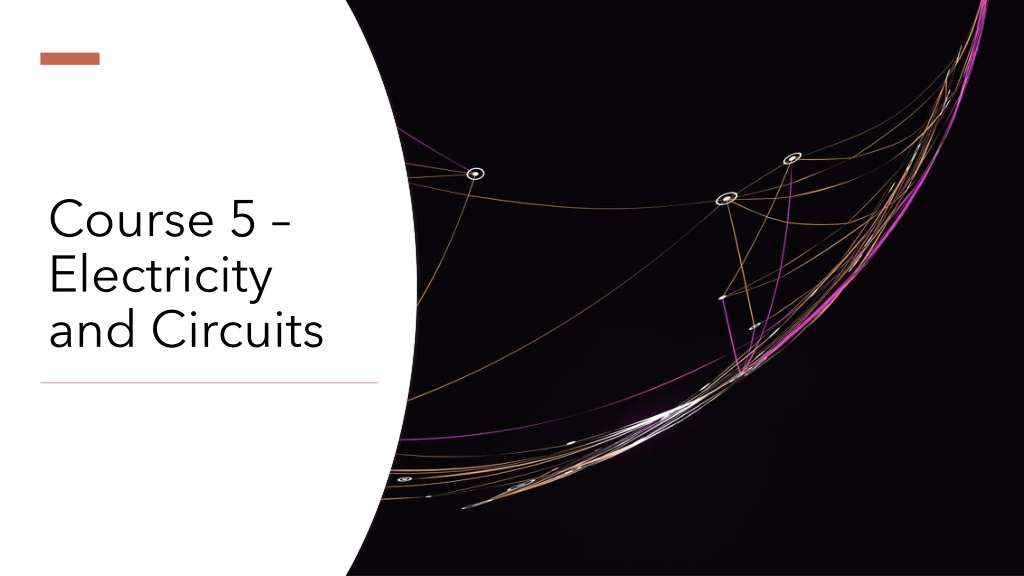Understanding Electricity and Circuits: Basics, Components, and Applications
This educational course covers topics such as circuit symbols, calculating and measuring electrical quantities, identifying circuits, and understanding the relevance of electricity in engineering. It explains essential circuit components like energy sources, conductors, insulators, loads, control devices, and protection devices. The course also discusses schematic diagrams, electrical symbols, laws such as Ohm's law, and practical examples of circuits with components. Additionally, a discussion on the importance of protection devices in circuits is presented.
Download Presentation

Please find below an Image/Link to download the presentation.
The content on the website is provided AS IS for your information and personal use only. It may not be sold, licensed, or shared on other websites without obtaining consent from the author. Download presentation by click this link. If you encounter any issues during the download, it is possible that the publisher has removed the file from their server.
E N D
Presentation Transcript
Course 5 Electricity and Circuits
Objectives Circuit symbols Calculating electrical quantities Measuring electrical quantities Identifying circuits Measuring circuits
Relevancy To understand the basics of electricity To promote an engineering mindset NABCEP PV Associate certification CVQ level 2
Circuits Energy source to provide voltage Conductors to allow current to flow Insulators to confine current to desired path Load to convert electrical energy to desired energy Control device to start or stop the flow of current Protection device to protect circuit during a malfunction
Circuits Provide an example of: Energy Source Conductors Insulators
Circuits Provide an example of: Load Control device Protection device
Circuits Based on the previous list: which components are essential Which components are not essential
Schematic Diagram Cell Switch Wire Lamp
Lamp Circuit This Photo by Unknown Author is licensed under CC BY-NC-ND
Discussion Should we have protection devices? Are there benefits to having/using protection devices?
Electrical Symbols (Wikibooks, 2005)
Electrical Quantities ??????? (?) ?????????? (?) Ohm s law ??????? ? = Watt s law (power law) ????? ? = ??????? ? ??????? (?)
Electrical Laws Resistance in a wire relationship Ohm's law relationship (Rider, 2012)
Calculating Electrical Quantities If the circuit on the right is powered by 1.5 volt cell and has a current of 200 milliamp, what is the circuit resistance? This Photo by Unknown Author is licensed under CC BY-NC-ND
Calculating Electrical Quantities If the circuit on the right is powered by 1.5 volt cell and has a current of 200 milliamp, what is the circuit resistance? ? =? ? ? =1.5 ????? 0.2 ???? ? = 7.5 This Photo by Unknown Author is licensed under CC BY-NC-ND
Calculating Electrical Quantities An customer has a 8 watt LED light on for 24 hours of the day. How much energy did the light use?
Calculating Electrical Quantities An customer has a 8 watt LED light on for 24 hours of the day. How much energy did the light use? ?????? = ????? ????
Calculating Electrical Quantities An customer has a 8 watt LED light on for 24 hours of the day. How much energy did the light use? ?????? = ????? ???? ?????? = 8 ????? 24 ????
Calculating Electrical Quantities An customer has a 8 watt LED light on for 24 hours of the day. How much energy did the light use? ?????? = ????? ???? ?????? = 8 ????? 24 ???? ?????? = 192 ???? ???? ?? 0.192 ??
Calculating Electrical Quantities An customer has a 8 watt LED light on for 24 hours of the day. How much did the customer pay the utility company?
Calculating Electrical Quantities An customer has a 8 watt LED light on for 24 hours of the day. How much did the customer pay the utility company? ???? = ?????? ????
Calculating Electrical Quantities An customer has a 8 watt LED light on for 24 hours of the day. How much did the customer pay the utility company? ???? = ?????? ???? ???? = 0.192 ?? $0.33 ??
Calculating Electrical Quantities An customer has a 8 watt LED light on for 24 hours of the day. How much did the customer pay the utility company? ???? = ?????? ???? ???? = 0.192 ?? $0.33 ?? ???? = $0.06336
Measuring Electrical Quantities Voltage is measured in parallel Current is measured in series Resistance is measured in parallel with power off A multimeter has the capability to do multiple functions
Circuits Series Parallel Series-Parallel
Series-Parallel A combination of a series and parallel circuit This example is relatively simple This Photo by Unknown Author is licensed under CC BY
Series-Parallel A combination of a series and parallel circuit This example is more difficult
How is it Connected? This Photo by Unknown Author is licensed under CC BY-SA This Photo by Unknown Author is licensed under CC BY-SA























